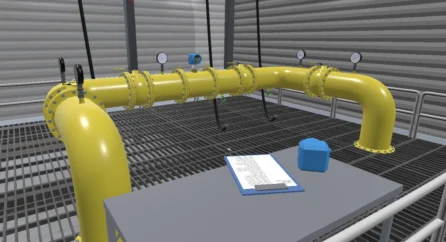Home Knowledge Base How the latest ARKit update is transforming augmented reality
How the latest ARKit update is transforming augmented reality
15th February 2018

With only 2,000 ARKit-enabled apps to its name, and installs showing a downward trend, the hype around Apple’s augmented reality technology went quickly from red-hot to luke-warm. News of the latest ARKit update has reignited excitement amongst developers and brands alike, with the changes inching us closer to a new world of AR possibilities and increased adoption. The question is, can Apple’s news finally be the much-anticipated catalyst that shifts the current lack-luster perception of AR from short-term gimmick to long-term staple for brands.
Apple’s recent ARKit changes have opened up an ocean of possibilities for AR experiences, and the quiet ripples around the AR debate have quickly massed into tidal waves. Developers, brands and consumers are starting to understand that AR can indeed be more than a bit of fun: it can be genuinely useful. And this realisation might just push ARKit adoption on a whole new trajectory.
Marked believable change
From a developer’s perspective, the changes allow them to make their AR experiences react to the real world in a much more believable and accurate way. Before ARKit, most developers could only really use marker-based AR, which restricted the experience to being overlaid on a physical marker in the real world – and if that marker moved out of the field of view of the camera, the experience would disappear.
Then, when ARKit first launched, it took away the need for the marker – giving developers much more freedom by suddenly enabling the experience to be anywhere around you. But it was still limited – it could only detect horizontal surfaces such as tables and floors, which meant that although you could do things such as simulate a ball bouncing off the floor, you couldn’t bounce it off a wall or a door or a pillar. The experience would stop working, thus breaking the illusion.
But this new update provides the additional functionality that allows you to be able to track walls and doors and any vertical surface. So, not only can your AR objects interact with those surfaces – for instance, an animated character leaning against a doorframe – it also means that the effects within the experience, such as lighting, can be made much more realistic.
For example, we can simulate lighting within the experience to reflect where windows and doors would be in a space, therefore casting shadows and reflections that are true to life. All of this adds an additional level of believability – making the experience more immersive, while allowing developers to have more fun too.
The other major feature that ARKit adds is the ability to detect markers, which it couldn’t actually do before. This means you can layer your AR experience with triggers for new content. So, you could be using an AR experience which then detects a marker, which then triggers the next stage of content – giving you a staggered and comprehensive overall experience.
This opens up all sorts of exciting opportunities, from gaming to storytelling to brand experiences. And the more compelling the experience, the more developers will be interested in trying it and engaging with it.
Power to the people
To date, the growth and adoption of AR has been stunted by its Achilles Heel: the widespread perception that it’s cool, but not very useful. In reality, devices like the Microsoft HoloLens have shown us that far from being a gimmick, AR can be an incredibly powerful tool. You only have to read about the medical uses the HoloLens is being put to – for example, during cross-continent surgery – to see that.
What this ARKit update does is put the power that the (very expensive) HoloLens offers into the hands of anybody with a reasonably modern smartphone.
And the scope of use is diverse: from education to medicine, entertainment or construction. Imagine being able to point your tablet at a wall in a new building development and have X-ray vision showing you where all the pipework and cabling runs in the wall. That’s a genuinely useful application and it’s just there, on your smartphone, in your hand, in the moment.
Fortunately, amongst the serious talk, the fun hasn’t fizzled. There’s much more potential to design addictive and responsive AR mobile games too. So, all in all, the update will make AR more engaging and useful, both of which are crucial for adoption.
Return on reality
AR has always been about making an existing environment into something better than it already is – and the more it can model and reason with the environment it’s being used in, the more powerfully it can do that. This opens the floodgates of potential for in-the-moment AR experiences. Smart brands will turn this into an opportunity for enhanced ROI. The question is, how?
With augmented point of sale materials, brands can appeal to customers more directly, as Ferrari proved when AR first started attracting attention. Now the ARKit updates can take that direct appeal even further – making it accessible to everyone. Imagine a poster for a new car at a bus stop or in a waiting room. With ARKit, you scan the poster and the phone will put you in the point of view of the driver, so you’re free to explore the inside of the car with a good sense of scale. You could slide over to the passenger seat to see what that’s like. Turn around to look in the back. You could even reduce the car to a radio control size and drive it around on the sidewalk in front of you.
All this demonstrates a valuable opportunity for brands to engage consumers with their products and services, while keeping them entertained and engaged.
Is that as far as it goes? No. The new changes to ARKit can springboard brands into a new world of customer experience. Done right, brands can now help customers get up close and personal with virtual representations of their products and services in any environment at any time. There is opportunity to turn anyone’s landscape into engaging brand content, whether it’s a game, product demonstration or just a bit of fun. Imagine a virtual Natalie Portman showing you how to apply your Dior lipstick at your own dressing table, or flying a virtual version of a toy drone in a toyshop.
Join the AR-evolution
Undeniably, it’s an exciting time for AR, and the latest updates to Apple’s ARKit shine a light on what could happen next. Is there a way to separate ARkit from the phone, so it can potentially be viewed through glasses or a smart viewer? When usage evolves and perceptions shift, AR of the future could truly become an additional layer over everyday life – and adoption will soar.
Right now, brands are perfectly placed to take advantage of the new opportunities ARkit has to offer by creating experiences that are both genuinely useful and genuinely engaging for their customers. Those smart brands who ride the ARKit wave now will be the ones to thrive in a truly AR-evolutionary future.
You can also find this blog post on VentureBeat.

James Burrows
Chief Executive Officer
Related posts

















